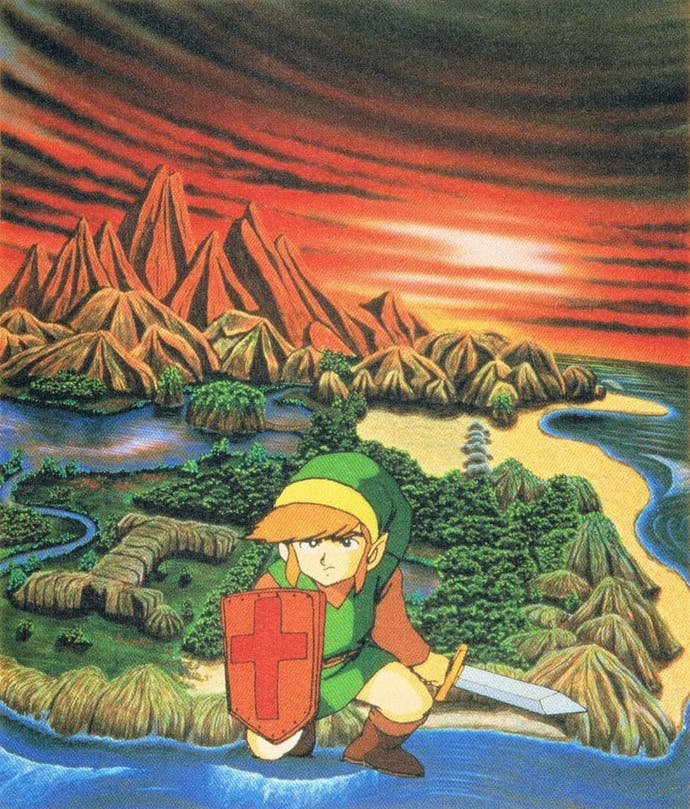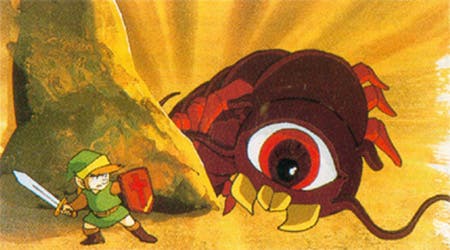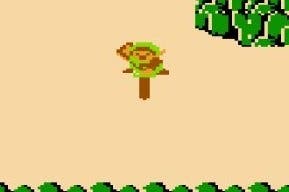Buried in the first Legend of Zelda is a glimpse of Dark Souls
A link to the future.
In the first dungeon - deep breath - I find a dark room hidden behind a door that is opened by a switch that is hidden behind a block. Wheels within wheels! And yet, things get stranger still. Inside this dark room that I have just uncovered stands an old man with a message: "The eastmost peninsula is the secret."
It takes a while to work yourself back into that mindset, into the memory of what games were like in 1986, and of the kinds of demands they typically made of their players. They weren't, in the main, very much like this. This game, at least, seems to think nothing of drawing you in deep - secrets behind secrets - and then flinging you far out across the huge map. Remember this detail, it seems to be saying. Beyond the immediate intricacy of this dungeon lies the greater intricacy of the world it is set within.

I appreciate it's a fairly obvious thing to remark upon at this point: that The Legend of Zelda speaks the same language as the current king of the action RPG, Dark Souls. It's still a bit of a shock to return to the source, however - to head back to 1986, glinting and unnaturally sharp on the screen of a 3DS, and see how much of Dark Souls is waiting for you right at the start of the whole thing. I loaded up the first Legend of Zelda earlier this week to reacquaint myself with the game that's apparently been a crucial touchstone for the designers working on the latest Zelda, Breath of the Wild. I thought it would be fun to see how forgotten ideas were being brought to life once again in what looks, on the surface, to be the most expansive and forward-thinking Zelda game in an age. Instead, I've found myself thinking: this is all so incredibly familiar. I've found myself thinking: a lot of this stuff never really got old in the first place.
Even now, there is a real sense of how dazzlingly inventive The Legend of Zelda must have been back in 1986. A game where the rest of the world doesn't disappear when it's off-screen! Where a clue might send you on an epic trek right across the landscape. A game that earned its save file, and where note-taking was pretty much compulsory. Everybody knows the origin story of Zelda, the story about a young Miyamoto who used to make his own lanterns to explore the caves dotted around his childhood home. But there's another origin story that feels less well-known, and perhaps more telling. Miyamoto's older in this one, he works at Nintendo and he's already made a few Mario games. One day he's in his office, playing with his desk, and as he opens and closes the drawers he imagines a perfect little landscape hidden in each one. Top-down, he's flicking between drawers, flicking between parts of this make-believe world. A lake in this one, a river running through mountains in the next. What if that river and that lake joined up? What if one fed the other and the mountains led you somewhere new?
And here's the big thing: what would players need to become in order to master that kind of world? That feels like a very Miyazaki (Hidetaka, Dark Souls mastermind) kind of question.

While it's true that so much of the classic Zelda DNA appears to have erupted fully-formed, there are still splinters of other games present, serving to further reinforce what a wrench this must have been for its designers. At times, the first Zelda is surprisingly arcadey, suggesting that Nintendo's developers couldn't quite leave behind the ceaseless action of Mario. It's weird, for instance, to see so many dungeon rooms that require you to kill everything in an enclosed space in order to proceed. Zelda: 2084! Then there are odd power-ups, like the clock, which freezes your foes for a limited period and feels like a natural companion to the Fire Flower and the Tanooki Suit. In the first dungeon, when picking up the bow, the perspective even switches to a side-on view as Link climbs a ladder. Madness! Except it's not madness at all. Zelda was just finding its feet, and would experiment, in fact, with more side-scrolling in its slightly weird sequel for the NES. And coming after that game, there's Link to the Past, the series' SNES masterpiece, which makes a lot more sense when you look at it from this perspective. Hyrule may have been split into two timelines, but the series itself was choosing which parts of its own history to build upon - and it chose the first Legend of Zelda.
In that choice, you really can see the origins of something that feels like Dark Souls. The Hyrule of Link to the Past is a beautiful place: those rounded, perfectly formed trees, that grass, those spattering rivers, that sleepy guy camping quietly beneath a bridge. In the original Legend of Zelda, however, Hyrule feels, well, a bit more like Lordran - a place of scarred earth and wasteland, parched and rugged and filled with horrible creatures that erupt from the sands or move in staggering hops. The Dark Souls combat is here in simplified form, sword and shield, timing and direction and pattern recognition, and the game throws strange items at you and explains almost nothing of itself. What's the blue note for? Why should I take it to the old lady when the journey is so dangerous? Should I hoard the bombs I've been given or spend them liberally, hoping to unlock hidden caves, each holding a vital heart container? Where, above all other concerns, should I go now? What should I head for? What am I doing? And why?

As with Dark Souls, you're dropped into an unforgiving and complex environment, a place of rules and rituals, few of which are initially exposed to the player. It's forbidding. But countering that is an approach to failure that, while strict, actually feels rather fair. In Dark Souls, you're essentially moving a lens of limited health around the world, venturing out in five- or ten-Estus-flask bursts as you slowly build up a mental map of the territory, each death sending you back to your last bonfire. Zelda feels very similar: those limited heart containers allow you five minutes of fumbling play in whichever direction you choose to explore, before your next disaster sends you back to the starting screen with limited health, but an increased understanding. Or, even better, it sends you back to the first room of the dungeon, with a greater sense of how things fit together and a bunch of new keys jangling in your pockets.
If Dark Souls has benefited from Zelda, then Zelda has in turn benefited from Dark Souls - and not just in the confidence the success of From Software's series must give Nintendo's designers when it comes to opening out Breath of the Wild's world while simultaneously focusing in on its core systems. Dark Souls has made me see the original game in the series afresh, in a way I would never have really looked at it before. I'm noticing little elements of the design that I'd always previously ignored.
Like those bosses. In the first Legend of Zelda, you tend to hear the bosses long before you see them, and I'd never clocked that until now. Terrifying, really. As you advance towards them across the intricate map of the dungeon you're lost within, you start to notice a distant, 8-bit growling. A roar from the deep. The boss is not in this room, nor the next or even the next, but you're getting closer to it. And when you meet it, it will be more deadly than you could ever have imagined.









